Image-Based Arabian Camel Breed Classification Using Transfer Learning on CNNs
Abstract
1. Introduction
- We introduce a new image dataset for Arabian camel breed classification, consisting of 1073 images of 6 different breeds of Arabian camels collected from various sources. The breeds are: Majaheem, Homor, Shaele, Shageh, Sofor, and Waddeh. To the best of our knowledge, this is the first and only dataset of its kind;
- We propose a machine learning application framework for image-based camel breed classification based on transfer learning. We use pre-trained CNNs as feature extractors, fine-tune them on our new dataset, and retain only the best performing CNN in our final application system;
- We evaluate our model on our new dataset and compare it with several baselines and state-of-the-art methods. We show that our model achieves high accuracy and good generalization across different breeds and image conditions;
- We integrate our selected best-performing CNN into a mobile application for further validation and actual use in a real-world scenario.
2. Literature Review
2.1. ML-Based Approaches for Animal Classification and Detection
2.2. ML-Based Approaches for Classifying Other Animal Properties
2.3. ML-Based Approaches for Animal Breeds Classification
2.4. Discussion
3. Proposed Approach
3.1. Overall Pipeline
3.2. Arabian Camel Breed Dataset
3.2.1. Data Preprocessing
3.2.2. Dataset Partitioning
3.3. Convolutional Neural Network Model
3.4. Evaluation Metrics
3.5. CamelBreeds App
4. Experimentation
4.1. Experimental Setup
4.2. Pre-Trained CNNs and Hyperparameter Settings
4.3. Experimental Results
4.4. Data Augmentation Discussion
- Random rotation: This technique randomly rotates the images by a certain angle within a specified range. We expected this to introduce some variations in the orientation of the images and make the model more invariant to rotation, but it did not have any noticeable effect on the accuracy or loss;
- Random flipping: This technique randomly flips the images horizontally or vertically (only horizontally in our experiment). We expected this to introduce some variations in the symmetry of the images and make the model more invariant to flipping but it did not have any noticeable effect on the accuracy or loss;
- Rescaling: This technique randomly rescales the images by a certain factor within a specified range. We expected this to introduce some variations in the size of the images and make the model more invariant to scaling but it did not have any noticeable effect on the accuracy or loss;
- Random contrast adjustment: This technique randomly adjusts the contrast of the images by a certain factor within a specified range. We expected this to introduce some variations in the brightness of the images and make the model more invariant to contrast but it did not have any noticeable effect on the accuracy or loss.
5. Conclusions and Future Work
Author Contributions
Funding
Institutional Review Board Statement
Informed Consent Statement
Data Availability Statement
Acknowledgments
Conflicts of Interest
References
- Alhajeri, B.H.; Alaqeely, R.; Alhaddad, H. Classifying camel breeds using geometric morphometrics: A case study in Kuwait. Livest. Sci. 2019, 230, 103824. [Google Scholar] [CrossRef]
- Abdallah, H.R.; Faye, B. Phenotypic classification of Saudi Arabian camel (Camelus dromedarius) by their body measurements. Emir. J. Food Agric. 2012, 24, 272–280. [Google Scholar]
- Gheisari, M.; Ebrahimzadeh, F.; Rahimi, M.; Moazzamigodarzi, M.; Liu, Y.; Dutta Pramanik, P.K.; Heravi, M.A.; Mehbodniya, A.; Ghaderzadeh, M.; Feylizadeh, M.R.; et al. Deep learning: Applications, architectures, models, tools, and frameworks: A comprehensive survey. CAAI Trans. Intell. Technol. 2023. [Google Scholar] [CrossRef]
- Khosla, A.; Jayadevaprakash, N.; Yao, B.; Fei-Fei, L. Novel Dataset for Fine-Grained Image Categorization. In Proceedings of the First Workshop on Fine-Grained Visual Categorization, IEEE Conference on Computer Vision and Pattern Recognition, Colorado Springs, CO, USA, 20–25 June 2011. [Google Scholar]
- Parkhi, O.M.; Vedaldi, A.; Zisserman, A.; Jawahar, C. Cats and dogs. In Proceedings of the 2012 IEEE Conference on Computer Vision and Pattern Recognition, Providence, RI, USA, 16–21 June 2012; pp. 3498–3505. [Google Scholar]
- Zou, D.N.; Zhang, S.H.; Mu, T.J.; Zhang, M. A new dataset of dog breed images and a benchmark for fine-grained classification. Comput. Vis. Media 2020, 6, 477–487. [Google Scholar] [CrossRef]
- Szegedy, C.; Vanhoucke, V.; Ioffe, S.; Shlens, J.; Wojna, Z. Rethinking the inception architecture for computer vision. In Proceedings of the IEEE Conference on Computer Vision and Pattern Recognition, Las Vegas, NV, USA, 27–30 June 2016; pp. 2818–2826. [Google Scholar]
- Zoph, B.; Vasudevan, V.; Shlens, J.; Le, Q.V. Learning transferable architectures for scalable image recognition. In Proceedings of the IEEE Conference on Computer Vision and Pattern Recognition, Salt Lake City, UT, USA, 18–23 June 2018; pp. 8697–8710. [Google Scholar]
- Liu, C.; Zoph, B.; Neumann, M.; Shlens, J.; Hua, W.; Li, L.J.; Fei-Fei, L.; Yuille, A.; Huang, J.; Murphy, K. Progressive neural architecture search. In Proceedings of the European Conference on Computer Vision (ECCV), Munich, Germany, 8–14 September 2018; pp. 19–34. [Google Scholar]
- Howard, A.; Sandler, M.; Chu, G.; Chen, L.C.; Chen, B.; Tan, M.; Wang, W.; Zhu, Y.; Pang, R.; Vasudevan, V.; et al. Searching for mobilenetv3. In Proceedings of the IEEE/CVF International Conference on Computer Vision, Seoul, Republic of Korea, 27–28 October 2019; pp. 1314–1324. [Google Scholar]
- Tan, M.; Le, Q. Efficientnetv2: Smaller models and faster training. In Proceedings of the International Conference on Machine Learning (PMLR), Virtual Event, 18–24 July 2021; pp. 10096–10106. [Google Scholar]
- Pardamean, B.; Cenggoro, T.W.; Rahutomo, R.; Budiarto, A.; Karuppiah, E.K. Transfer learning from chest x-ray pre-trained convolutional neural network for learning mammogram data. Procedia Comput. Sci. 2018, 135, 400–407. [Google Scholar] [CrossRef]
- Alsaadi, E.M.T.A.; El Abbadi, N.K. An Automated Classification of Mammals and Reptiles Animal Classes Using Deep Learning. Iraqi J. Sci. 2020, 61, 2361–2370. [Google Scholar] [CrossRef]
- Trnovszky, T.; Kamencay, P.; Orjesek, R.; Benco, M.; Sykora, P. Animal recognition system based on convolutional neural network. Adv. Electr. Electron. Eng. 2017, 15, 517–525. [Google Scholar] [CrossRef]
- Liu, B.; Liu, Y.; Zhou, K. Image Classification for Dogs and Cats. In Proceedings of the IEEE Computer Society Conference, Tokyo, Japan, 23–27 July 2018; Volume 1. [Google Scholar]
- Zeng, P. Research on Similar Animal Classification Based on CNN Algorithm. J. Phys. Conf. Ser. 2021, 2132, 012001. [Google Scholar] [CrossRef]
- Lin, L. Household Animals Classification Using Deep Learning; Stanford University: Stanford, CA, USA, 2020. [Google Scholar]
- Khandale, C.; Ramdev, M. Animal Classification using Deep Learning Inception-v3 Model on Tensor flow. Int. J. Adv. Res. Comput. Commun. Eng. 2019, 8, 61–66. [Google Scholar] [CrossRef]
- Zamansky, A.; Sinitca, A.M.; Kaplun, D.I.; Dutra, L.M.; Young, R.J. Automatic estimation of dog age: The dogage dataset and challenge. In Proceedings of the Artificial Neural Networks and Machine Learning–ICANN 2019: Image Processing: 28th International Conference on Artificial Neural Networks, Munich, Germany, 17–19 September 2019; Volume 11729 LNCS. [Google Scholar] [CrossRef]
- Wang, H.; Su, H.; Chen, P.; Hou, R.; Zhang, Z.; Xie, W. Learning deep features for giant panda gender classification using face images. In Proceedings of the IEEE/CVF International Conference on Computer Vision Workshops, Seoul, Republic of Korea, 27 October–2 November 2019. [Google Scholar] [CrossRef]
- Varshney, A.; Katiyar, A.; Singh, A.K.; Chauhan, S.S. Dog Breed Classification Using Deep Learning. In Proceedings of the 2021 International Conference on Intelligent Technologies (CONIT), Hubli, India, 25–27 June 2021. [Google Scholar] [CrossRef]
- Raduly, Z.; Sulyok, C.; Vadaszi, Z.; Zolde, A. Dog Breed Identification Using Deep Learning. In Proceedings of the IEEE 16th International Symposium on Intelligent Systems and Informatics, Subotica, Serbia, 13–15 September 2018. [Google Scholar] [CrossRef]
- Borwarnginn, P.; Kusakunniran, W.; Karnjanapreechakorn, S.; Thongkanchorn, K. Knowing Your Dog Breed: Identifying a Dog Breed with Deep Learning. Int. J. Autom. Comput. 2021, 18, 45–54. [Google Scholar] [CrossRef]
- Mulligan, K.; Rivas, P. Dog Breed Identification with a Neural Network over Learned Representations from The Xception CNN Architecture. In Proceedings of the 21st International Conference on Artificial Intelligence (ICAI 2019), Xuzhou, China, 22–23 August 2019. [Google Scholar]
- Gupta, K.; Goel, S.; Aggarwal, B.; Gupta, R. Dog Breed identification using CNN Architecture. Int. J. Sci. Eng. Res. 2020, 11, 1040–1046. [Google Scholar]
- Shi, W.; Chen, J.; Liu, M.; Liu, F. Dog Breed Identification; University of California: San Diego, CA, USA, 2018; Available online: http://noiselab.ucsd.edu/ECE228_2018/Reports/Report18.pdf (accessed on 1 July 2023).
- Ayanzadeh, A.; Vahidnia, S. Modified deep neural networks for dog breeds identification. Preprints.org 2018, 2018120232. [Google Scholar] [CrossRef]
- Agh Atabay, H. Deep Learning for Horse Breed Recognition. CSI J. Comput. Sci. Eng. 2018, 15, 45–51. [Google Scholar]
- de la Cal, E.; García González, E.; Villar, J.R. Transfer Learning Study for Horses Breeds Images Datasets Using Pre-trained ResNet Networks. In Proceedings of the Hybrid Artificial Intelligent Systems: 16th International Conference (HAIS 2021), Bilbao, Spain, 22–24 September 2021. [Google Scholar] [CrossRef]
- Fu, Y.; Huang, X.; Li, Y. Horse Breed Classification Based on Transfer Learning. In Proceedings of the 4th International Conference on Advances in Image Processing, Chengdu, China, 13–15 November 2020; Association for Computing Machinery: New York, NY, USA, 2020; Volume PartF169255, pp. 42–47. [Google Scholar] [CrossRef]
- Pan, Y.; Jin, H.; Gao, J.; Rauf, H.T. Identification of Buffalo Breeds Using Self-Activated-Based Improved Convolutional Neural Networks. Agriculture 2022, 12, 1386. [Google Scholar] [CrossRef]
- Salama, A.; Hassanien, A.E.; Fahmy, A. Sheep Identification Using a Hybrid Deep Learning and Bayesian Optimization Approach. IEEE Access 2019, 7, 31681–31687. [Google Scholar] [CrossRef]
- Agrawal, D.; Minocha, S.; Namasudra, S.; Kumar, S. Ensemble Algorithm using Transfer Learning for Sheep Breed Classification. In Proceedings of the 2021 IEEE 15th International Symposium on Applied Computational Intelligence and Informatics (SACI), Timisoara, Romania, 19–21 May 2021. [Google Scholar] [CrossRef]
- Banik, S.; Mustafi, S.; Mandal, S.; Ghosh, P.; Dan, S.; Mukherjee, K.; Roy, K.; Hajra, D. Identification of Goat Breeds by Digital Image Using Convolution Neural Network. Reason.-Tech. J. 2020, 18, 64–74. [Google Scholar] [CrossRef]
- TensorFlow Hub. Available online: https://www.tensorflow.org/hub (accessed on 5 June 2023).
- TensorFlow. Available online: https://www.tensorflow.org (accessed on 5 June 2023).
- Google Colab. Available online: https://colab.research.google.com/ (accessed on 5 June 2023).
- Hinton, G.; Srivastava, N.; Krizhevsky, A.; Sutskever, I.; Salakhutdinov, R. Improving neural networks by preventing co-adaptation of feature detectors. arXiv 2012, arXiv:1207.0580. [Google Scholar]
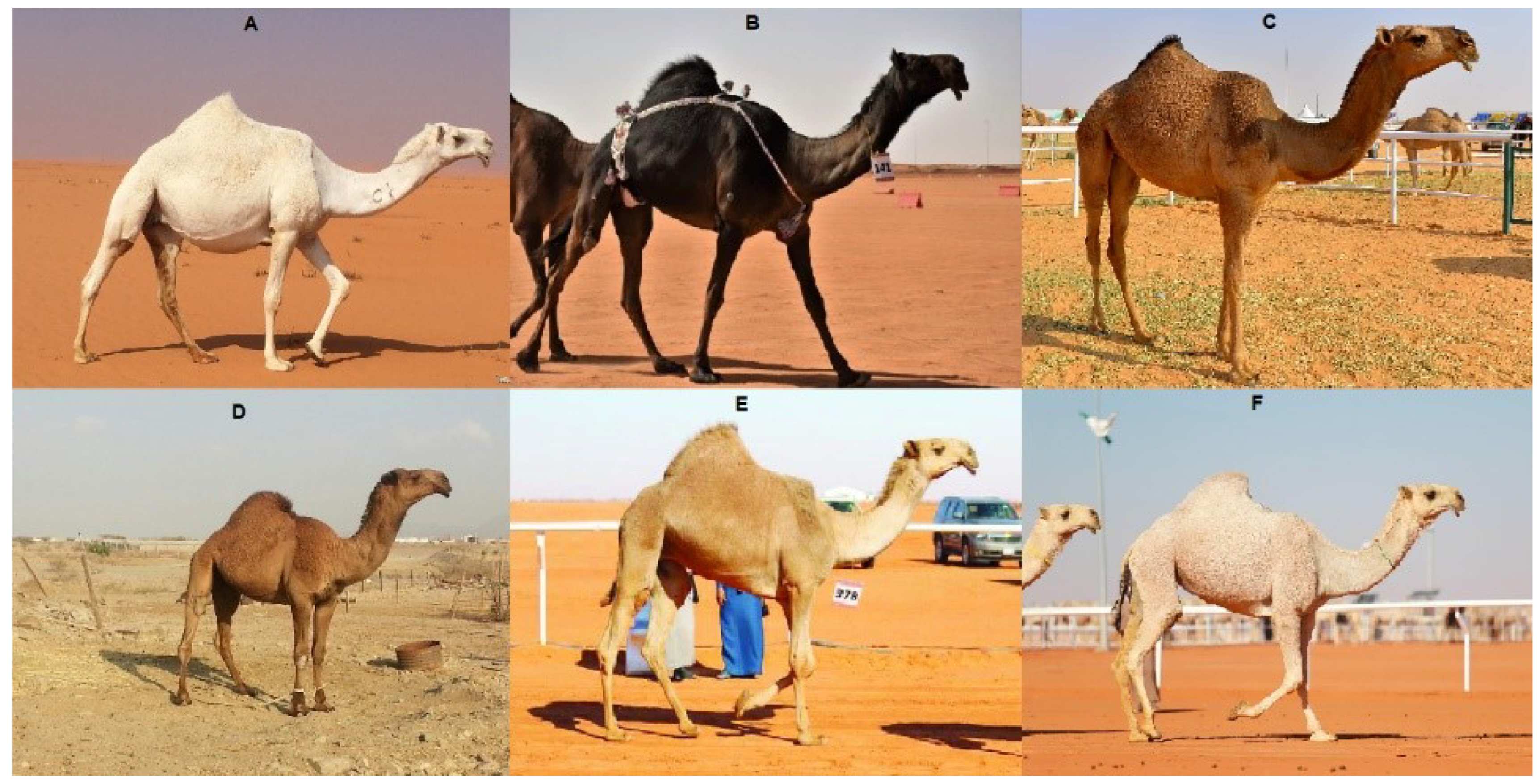
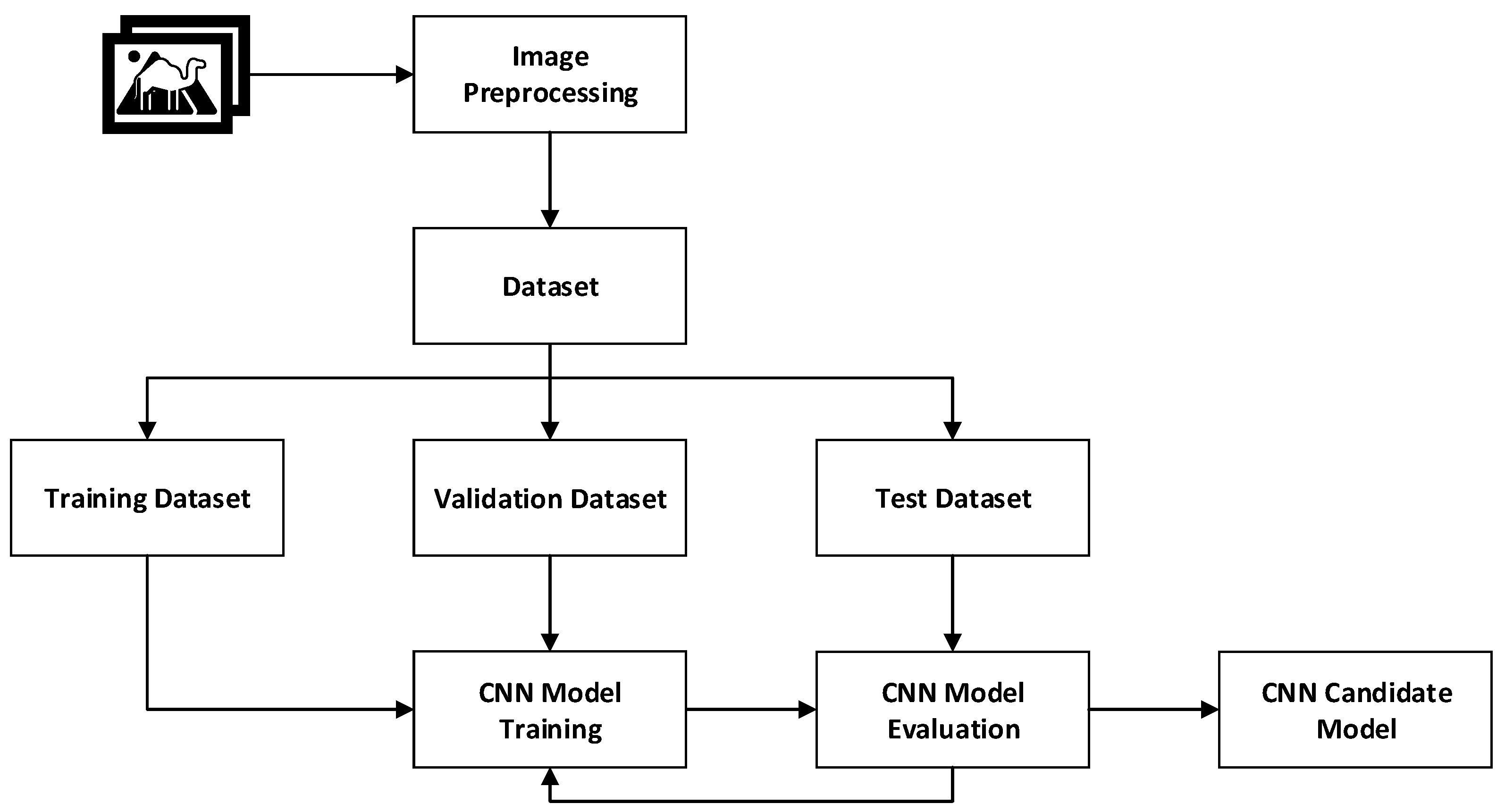
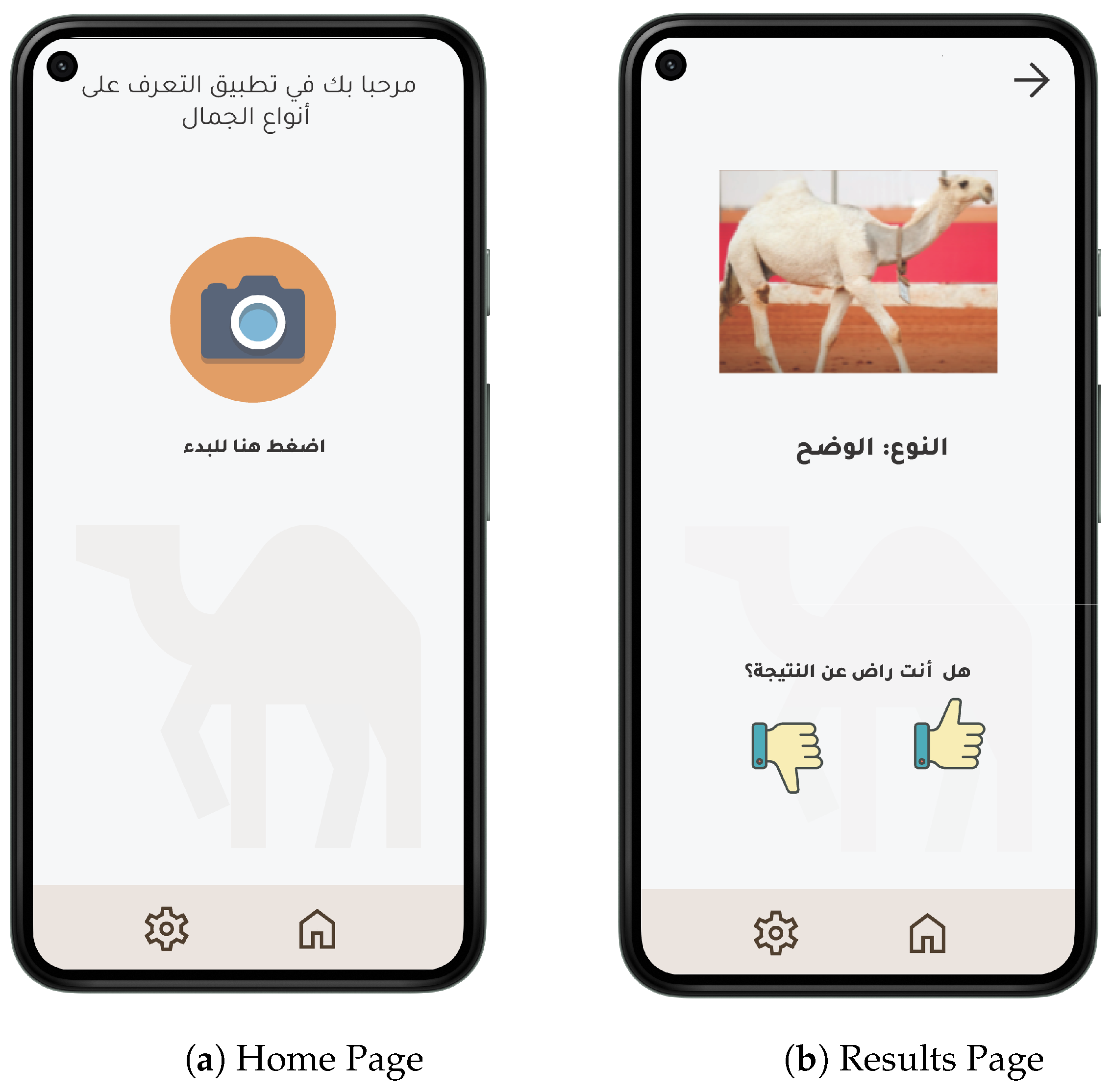

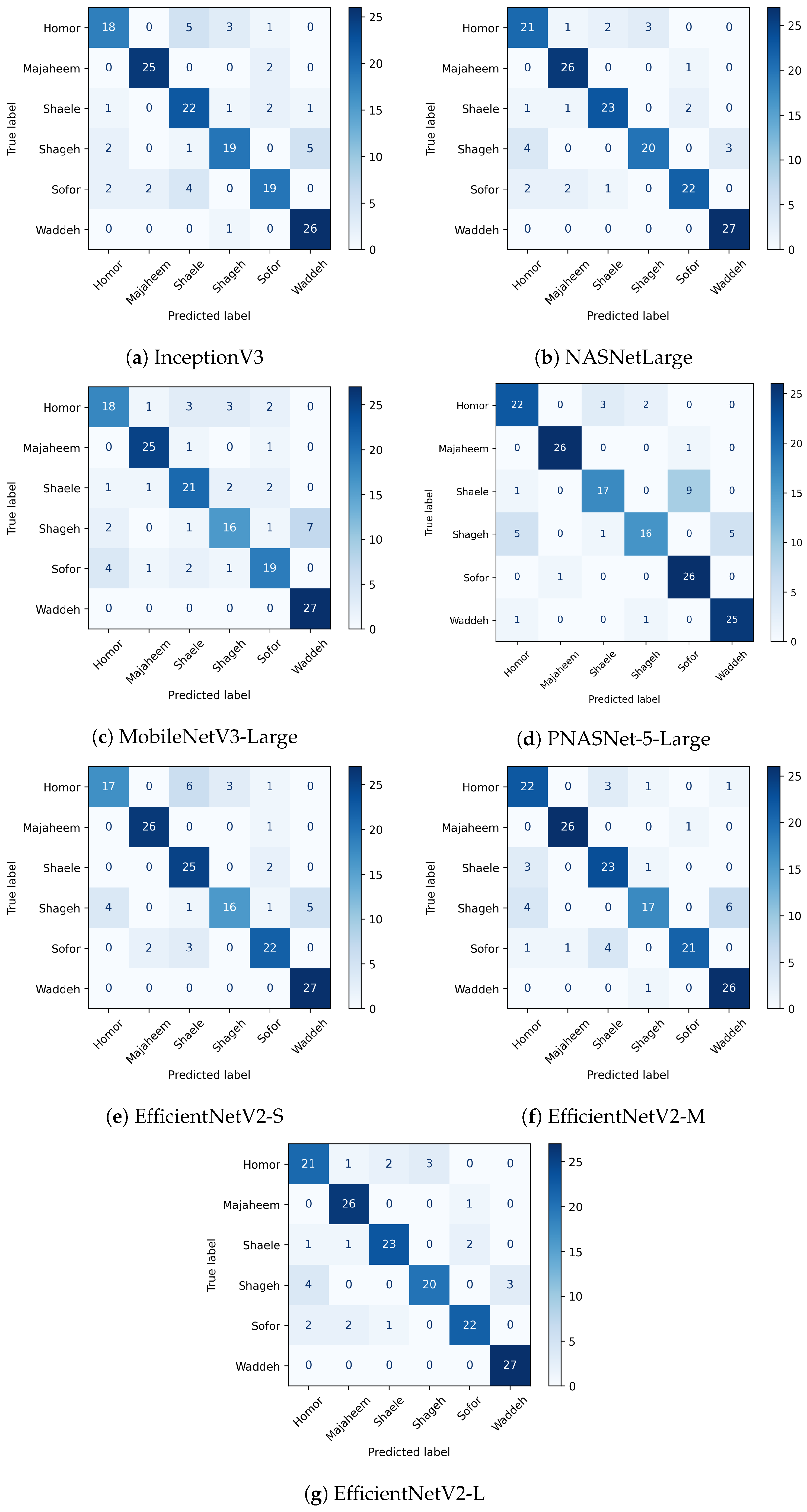
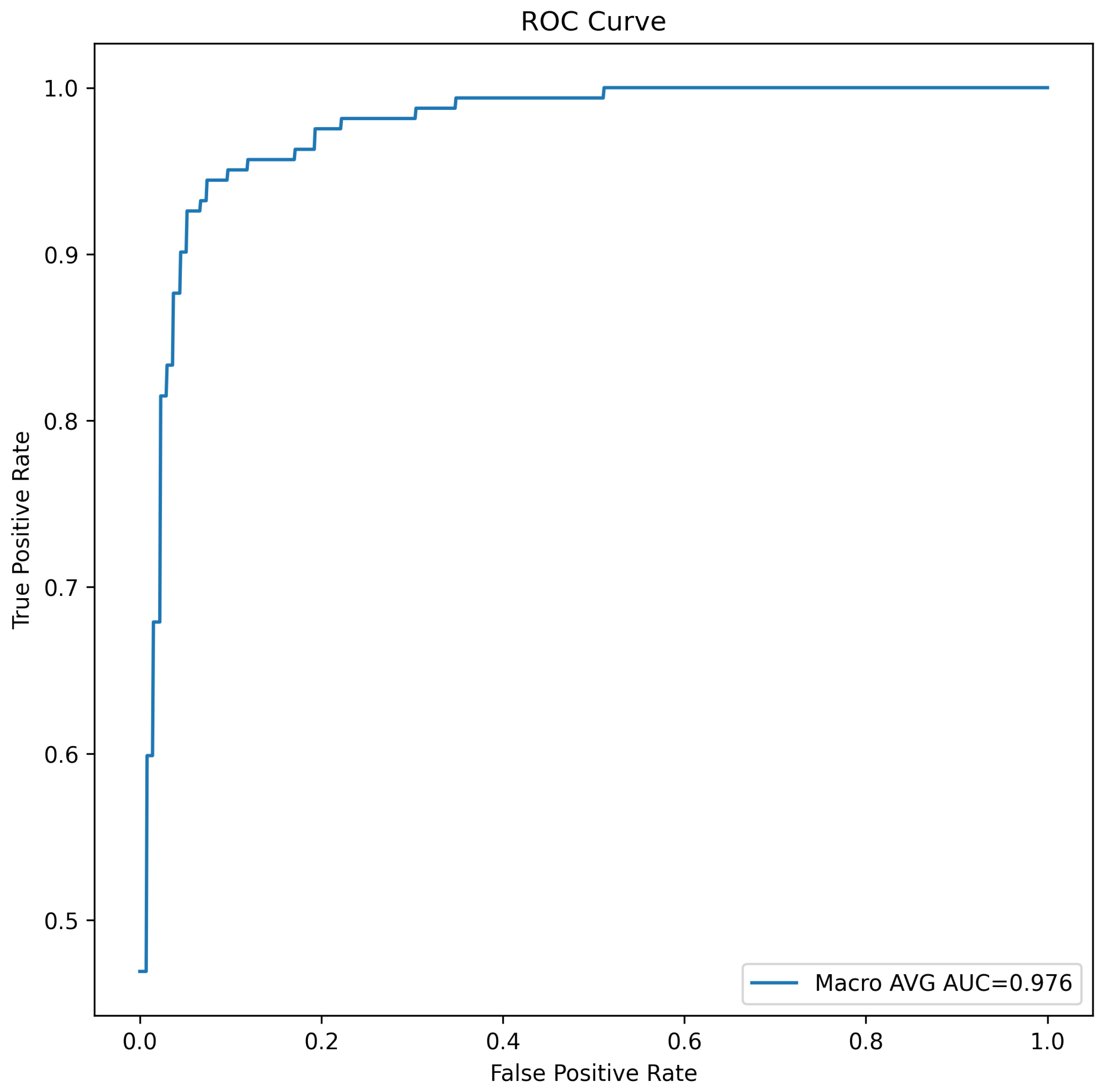
| Class | Training | Validation | Test | Total Images |
|---|---|---|---|---|
| Waddeh | 125 | 27 | 27 | 179 |
| Majaheem | 125 | 28 | 27 | 180 |
| Homor | 125 | 28 | 27 | 180 |
| Sofor | 121 | 26 | 27 | 174 |
| Shaele | 125 | 28 | 27 | 180 |
| Shageh | 125 | 28 | 27 | 180 |
| Total | 746 | 165 | 162 | 1073 |
| Model | Year | Number of Parameters |
|---|---|---|
| InceptionV3 | 2015 | 23.8 million |
| NASNet-Large | 2018 | 88.9 million |
| PNASNet-5-Large | 2018 | 86.1 million |
| MobileNetV3-Large | 2019 | 5.4 million |
| EfficientNetV2-S | 2021 | 22 million |
| EfficientNetV2-M | 2021 | 54 million |
| EfficientNetV2-L | 2021 | 121 million |
| Model | Accuracy | F1 | AUC |
|---|---|---|---|
| InceptionV3 | 79.63 | 79 | 0.95 |
| NASNet-Large | 85.80 | 86 | 0.98 |
| PNASNet-5-Large | 81.48 | 81 | 0.95 |
| MobileNetV3-Large | 77.78 | 77 | 0.94 |
| EfficientNetV2-S | 82.10 | 81 | 0.95 |
| EfficientNetV2-M | 83.34 | 83 | 0.96 |
| EfficientNetV2-L | 83.95 | 84 | 0.96 |
| Model | Epochs | Training Time (s) | Inference Time (s) |
|---|---|---|---|
| InceptionV3 | 19 | 666.01 | 1 |
| NASNet-Large | 46 | 4805.74 | 0.97 |
| PNASNet-5-Large | 42 | 4180.67 | 0.69 |
| MobileNetV3-Large | 51 | 407.75 | 0.61 |
| EfficientNetV2-S | 47 | 1604.88 | 0.72 |
| EfficientNetV2-M | 41 | 3636.33 | 0.93 |
| EfficientNetV2-L | 34 | 5762.35 | 0.99 |
Disclaimer/Publisher’s Note: The statements, opinions and data contained in all publications are solely those of the individual author(s) and contributor(s) and not of MDPI and/or the editor(s). MDPI and/or the editor(s) disclaim responsibility for any injury to people or property resulting from any ideas, methods, instructions or products referred to in the content. |
© 2023 by the authors. Licensee MDPI, Basel, Switzerland. This article is an open access article distributed under the terms and conditions of the Creative Commons Attribution (CC BY) license (https://creativecommons.org/licenses/by/4.0/).
Share and Cite
Alfarhood, S.; Alrayeh, A.; Safran, M.; Alfarhood, M.; Che, D. Image-Based Arabian Camel Breed Classification Using Transfer Learning on CNNs. Appl. Sci. 2023, 13, 8192. https://doi.org/10.3390/app13148192
Alfarhood S, Alrayeh A, Safran M, Alfarhood M, Che D. Image-Based Arabian Camel Breed Classification Using Transfer Learning on CNNs. Applied Sciences. 2023; 13(14):8192. https://doi.org/10.3390/app13148192
Chicago/Turabian StyleAlfarhood, Sultan, Atheer Alrayeh, Mejdl Safran, Meshal Alfarhood, and Dunren Che. 2023. "Image-Based Arabian Camel Breed Classification Using Transfer Learning on CNNs" Applied Sciences 13, no. 14: 8192. https://doi.org/10.3390/app13148192
APA StyleAlfarhood, S., Alrayeh, A., Safran, M., Alfarhood, M., & Che, D. (2023). Image-Based Arabian Camel Breed Classification Using Transfer Learning on CNNs. Applied Sciences, 13(14), 8192. https://doi.org/10.3390/app13148192







